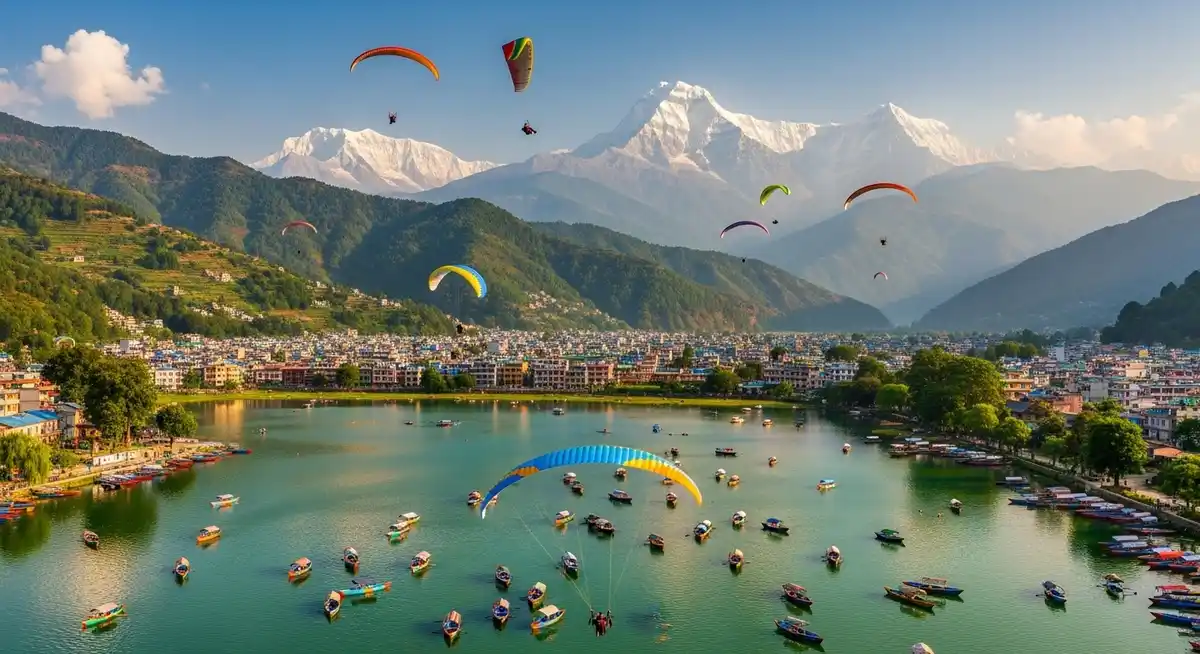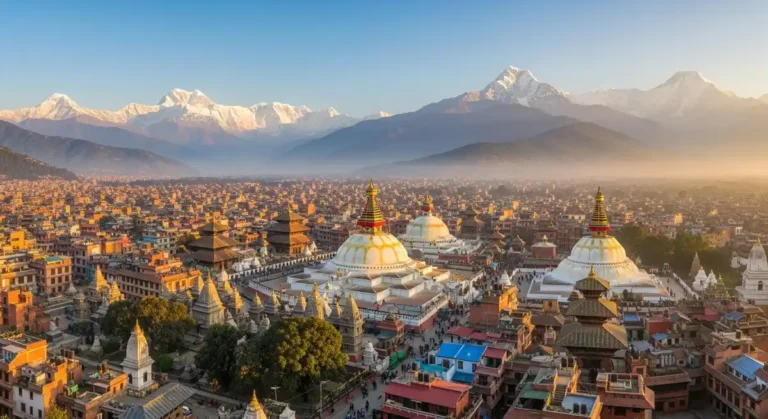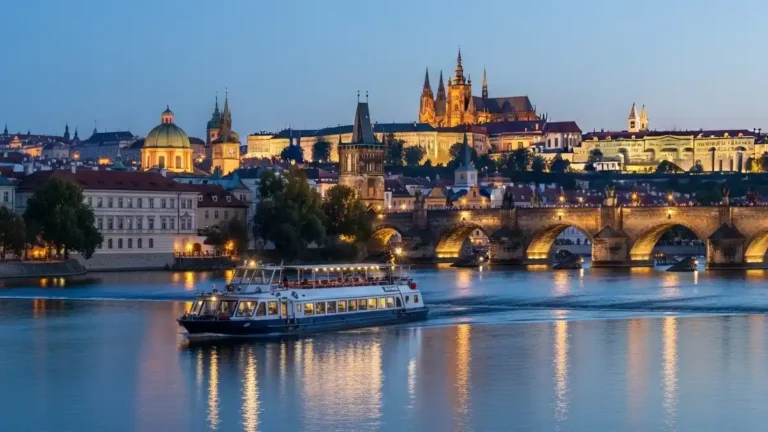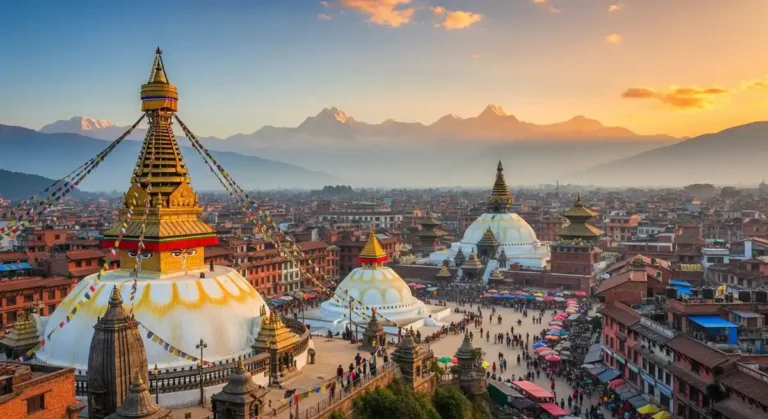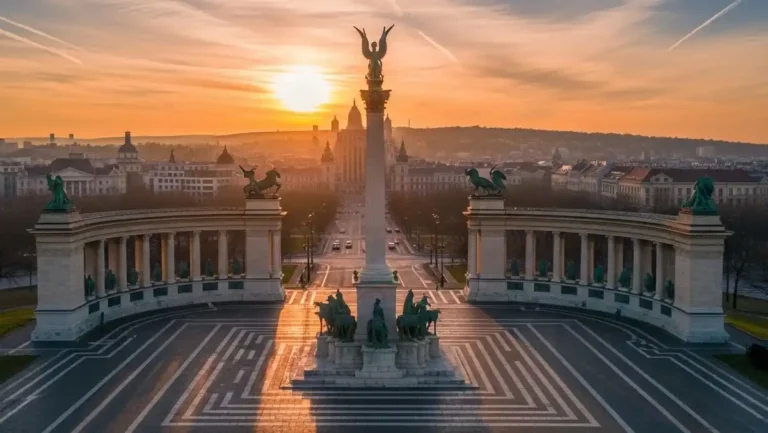Magical 22 Things to Do in Pokhara for an Unforgettable Trip in 2025
In the heart of Nepal, where snowy peaks kiss the sky and lakes mirror their beauty, Pokhara shines as a dreamscape of calm mornings, golden sunsets, and thrilling adventures.
Nestled in central Nepal, this metropolitan city feels like a place where time slows down. With the Annapurna Range rising high above and the calm waters of Phewa Lake below, it blends adventure, serenity, and rich culture in a way few destinations can.
Recognized in 2024 as the official tourism capital of Nepal, Pokhara welcomes travelers, from adventure enthusiasts to those seeking peaceful moments.
It is a natural gateway to the Annapurna Circuit, a renowned trail that attracts trekkers from around the world.
Beyond trekking, the skies open for paragliding from Sarangkot hill, while the waters invite boating, and rugged terrain inspires rock climbing, mountain biking, and canyoning.
The city is not only about thrill. A gentle boat ride on Phewa Lake, surrounded by towering peaks, offers a sense of calm. Visiting the World Peace Pagoda, a Buddhist stupa overlooking the valley, adds a touch of meditation and reflection.
Sunrise at Sarangkot paints the Himalayan peaks in gold, while evenings by cafés and guesthouses by the lakeside are perfect for unwinding.
Pokhara’s cultural heritage makes the journey even richer. Temples, monasteries, and religious festivals show the blend of Hindu and Buddhist cultures.
Places like the Bindhyabasini Temple, with its intricate architecture, and the bustling Mahendra Bazar or lakeside market, reveal traditions carried forward by artisans through generations.
The nearby Tibetan settlements and the International Mountain Museum highlight both unique culture and mountaineering history.
With its pristine air, snowy peaks, blue lakes, and lush greenery, many call Pokhara the jewel in the Himalaya. Whether for a short weekend getaway or a long holiday, the city of lakes offers something for everyone—from the excitement of ultra-light flights and zip-lining to the quiet joy of a stroll along the valley’s edge. It is a destination that balances excitement, serenity, and timeless natural beauty.
Pokhara Essentials
Best Time to Visit Pokhara
Autumn, from September to November, is the peak tourist season in Pokhara. The sky stays clear, the weather feels crisp, and the scenery looks beautiful with breathtaking views of the Himalayas.
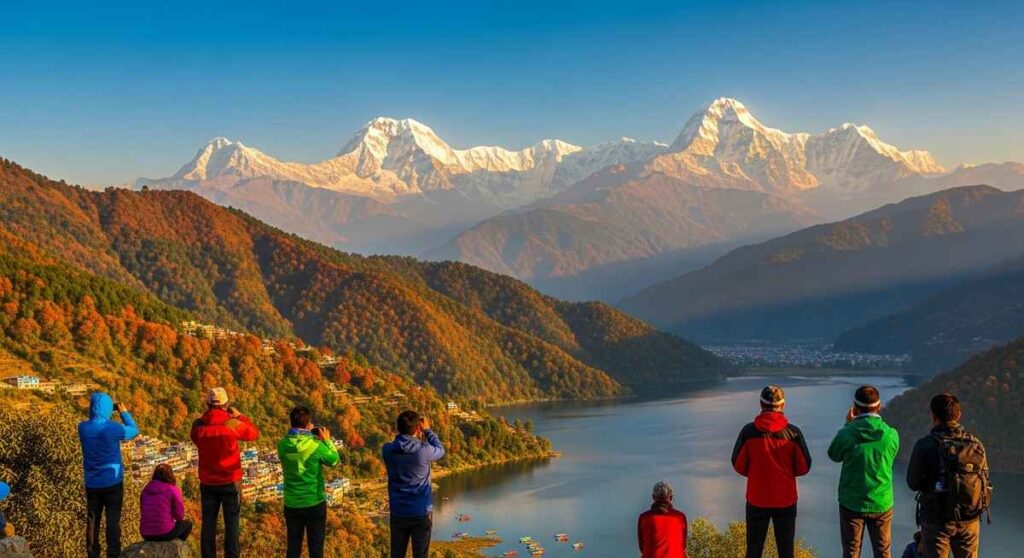
This is when many travellers enjoy trekking, hiking, and paragliding. I still remember the first time I saw the amazing vistas during this season—they looked truly mesmerising.
In Spring, from March to May, the city becomes warmer and full of rhododendron blooms. The walking paths are surrounded by flowers, and the outdoor activities feel more comfortable. Whether it’s bungee jumping, zip flying, or simple sightseeing, these months make the visit unforgettable.
Winter in December, January, and February is also pleasant in the lower areas. Days are beautiful and calmer, while nights feel a little chilly. For me, enjoying a quiet walk under clear skies in this season felt very rewarded.
Summer from May to August brings a touch of rain and humidity, but it also adds freshness to the city. By end of August, the weather improves, welcoming another round of Autumn, which is always a popular time among both budget and regular travellers.
With year-round festivities, every season in Nepal offers something special, but Autumn and Spring truly remain the best for a memorable visit.
How Many Days Should You Spend?
Pokhara offers something for every type of traveler. If your schedule is short, 2–3 days is usually enough for normal tourists to see the main attractions and enjoy light sightseeing. With a well-planned itinerary or package, along with an English-speaking guide and an air-conditioned car, the trip feels smooth and enjoyable.
For a relaxation seeker, more time brings more joy. The city’s peaceful vibe, cozy cafes, and calm lakeside views make it perfect for slow travel. Spending mornings near Phewa Lake or Begnas Lake, the second-largest in Pokhara, adds charm.
A massage, a yoga session, or simply sipping coffee while gazing at the Annapurna range creates wonderful memories.
For an adventure enthusiast or sightseeing lover, extra days are worth it. You can choose short day treks, a 3-day trek, or even a week trek or a 2-week trek in the Anuradhapura region.
Some travelers even recommend up to 20 days if combining long treks with sights. When I joined Bradley for sightseeing and light trekking, we found that 4–5 days gave us the best balance.
Here, every visitor can shape their interests into a journey—whether it’s relaxation, adventure, or a mix of both.
Getting There & Around (Flight, Bus, Car, Scooter, Cable Car)
Traveling to Pokhara from Kathmandu or nearby cities can be a beautiful experience. Whether you choose to fly, drive, or take a bus, each option offers a unique way to enjoy the journey and the scenery of Nepal. Once in the city, exploring places like the lakeside, footpaths, and back streets is simple with many local transport choices.
✈️ Flight
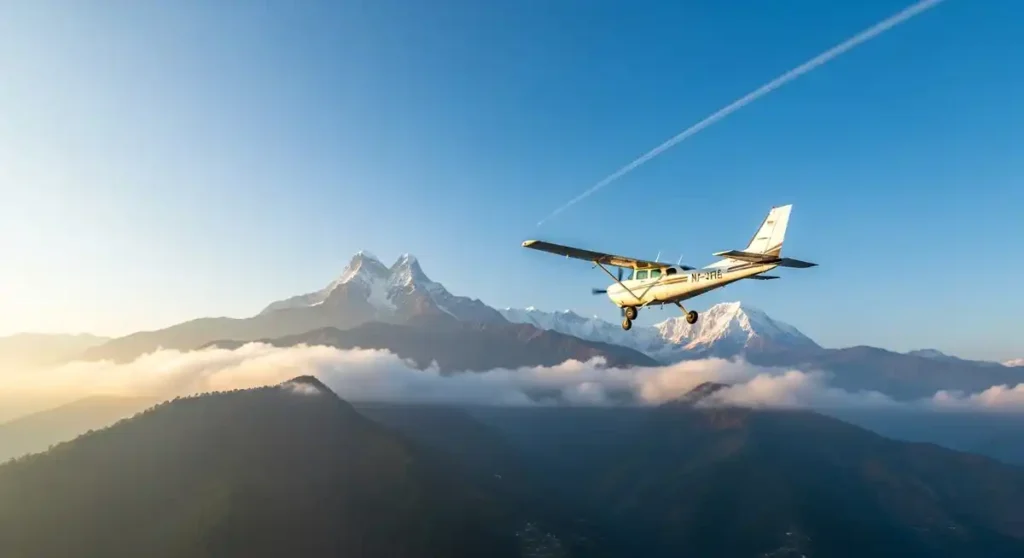
- The quickest way to reach Pokhara Airport is by Flight from Kathmandu.
- Popular airlines include Yeti Airlines, Buddha Airlines, and SimKirk Airlines.
- The journey takes just 25–30 minutes with wonderful views of the mountains and Phewa Lake.
- Domestic terminal services are smooth, making flying a time-saving option.
🚌 Bus
- A tourist bus from Kathmandu is a popular and affordable option.
- Some companies like Greenline and Mountain Overlander provide VIP, luxury, and sofa seat choices with extra comfort.
- The journey takes 8–12 hours, with stops for breakfast, lunch, and Nepalese street food.
- Many buses offer WiFi, free bottles of water, and are a great way to meet fellow travelers.
🚗 Car & Taxi
- A Private Car or Taxi can be booked directly or through an agent.
- Services like GetYourGuide offer private transfers in air-conditioned vehicles.
- Travel is hassle-free, affordable, and flexible, with plenty of chances to stop along the way.
- Taxis are also available within Pokhara, and the local app Taximandu makes it easy to schedule rides.
🛵 Scooter
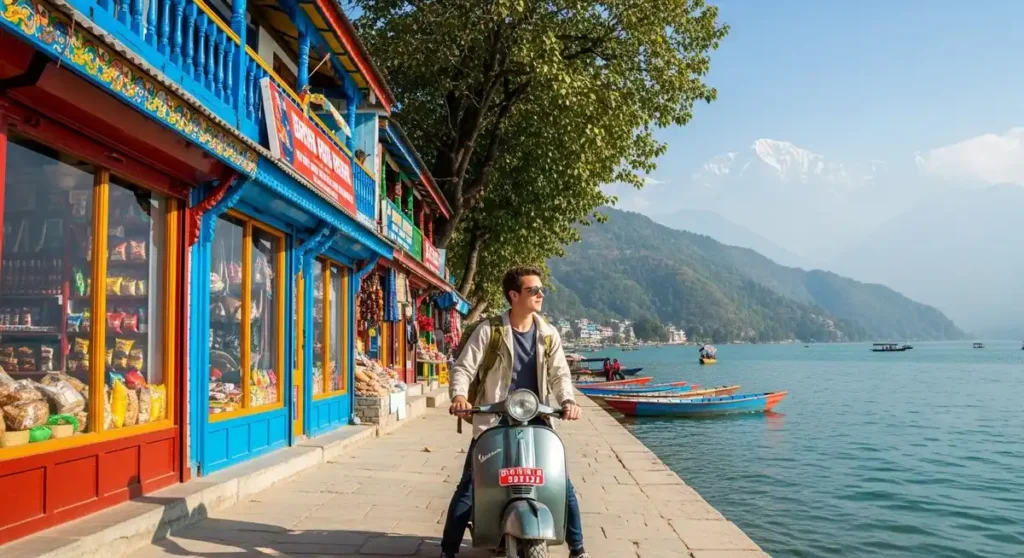
- Scooter Rental is ideal for exploring Pokhara at your own pace.
- Operators in the Lakeside area provide scooters for around 800–1200 NPR per day.
- It’s perfect for short trips around the city and discovering hidden corners near the lake.
🚡 Cable Car
- The Annapurna Cable Car offers scenic rides in just 10 minutes.
- Enjoy breathtaking views of Phewa Lake, the mountain ranges, and the city.
- The same company also offers Other Options like adventure activities, zip-lining, swings, and bungee jumping.
Pokhara is truly walkable, and whether by Bus, Car, Flight, Scooter, or Cable Car, every journey is an experience filled with natural beauty and comfort.
Lakes & Viewpoints (Pokhara’s Icons)
1. Phewa (Fewa) Lake – Boating & Tal Barahi Temple
On the southern side of the Pokhara valley, the Phewa lake shines as a true attraction for many tourists. The area of 4.43 sq.km is a stunning site where the reflection of the Machhapuchhre mountain glows at dawn, dusk, and in the afternoon.
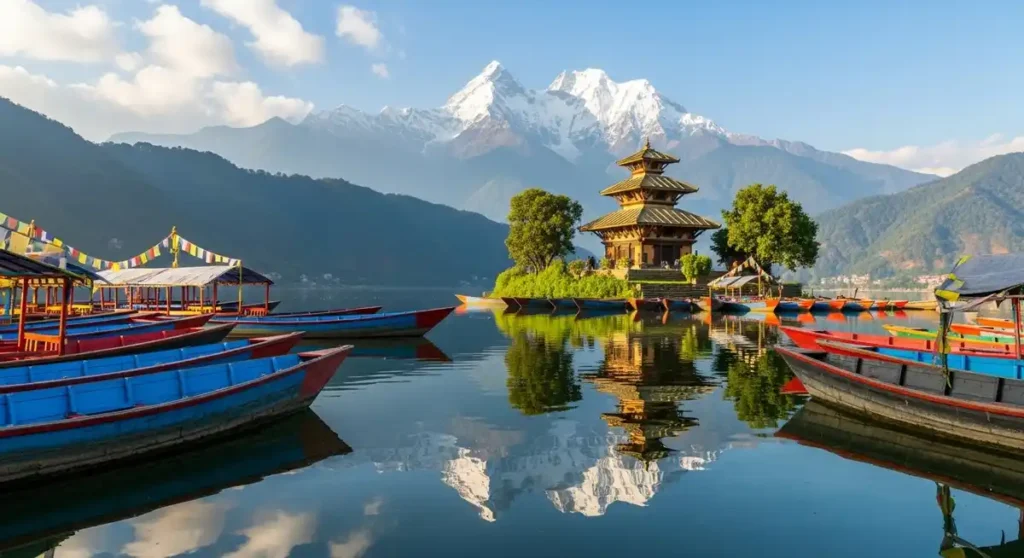
Every visitor finds joy in a boat ride on the emerald water. Along the banks of Lakeside, tourism thrives with peaceful lakeshore walks at sunset, the calls of birds, and the journey to the island that holds the Tal Barahi Temple, a cherished Hindu temple.
Taking a paddle in brightly painted doongas or hiring a boatsman makes the experience special. With prices starting from 500 NPR for an hour to 1000 NPR for a full day, it is easy and enjoyable.
The Fewa Lakes, the second largest in the Mountain Kingdom, measuring 1.5 by 4 km, are a center of attractions in Pokhara. Among the three lakes, this one is the most enchanting, known for its resplendence.
Travelers can sail, row, or take a hired boat across the water to the temple at the middle of the island. On the eastern shore, called Lakeside or Baidam, many find a welcoming home base with hotels, restaurants, and handicraft shops.
The Fewa Lake Lakeside tourist centre of Pokhara is a perfect place to relax, enjoy a restaurant meal, or prepare for a trek. With cozy cafes, this popular spot gives warm vibes that make travelers feel relaxed as soon as they arrive.
2. Sarangkot – Sunrise, Sunset & Annapurna Views
Sarangkot – Sunrise, Sunset & Annapurna Views is a true gem of Pokhara, Nepal. From this hilltop viewpoint, travelers see the panoramic Annapurna range, the mighty Dhaulagiri, and the sharp peak of Machhapuchhre (Fishtail Mountain). The colors of the sunrise and sunset light up the sky and paint the snowy mountains in shades of gold and crimson.

Just a short drive or hike from Pokhara Valley near Phewa Lake, the viewpoint at about 1592m–1600m altitude gives a wide-open view of Annapurna Massif, Manaslu, and other Himalayan peaks. Many tourist visitors love this spot in autumn between September and November when the weather is crystal clear.
The place is also a paragliding base. Flying here is a unique adventure seeker experience. With a pilot and glider, visitors soar through the Himalayan airspace, sharing the sky with griffin vultures, eagles, and kites.
The flight passes above villages, temples, monasteries, jungle, and Fewa Lake, giving a thrilling panorama of Lamjung Himal, Himchuli, Annapaurna Himal, and even rice fields, rivers, and small settlements.
Along the way, the path has surprises. A little art gallery run by a local Christian man shows warm pictures and even offers tea. The hiking trail, cable car, or taxi ride all lead to the base and then up to the peak, making it easy for all travelers. Entry is simple, and once on top, the scenery is unforgettable.
The mountainside ridge in Ward 18 of Kaski District, Nepal, is the perfect spot for anyone who loves sunrises, sunsets, nature, and hikes. Between 6:00 and 7:00 AM, the dawn scenery changes from purple to orange, giving a mesmerizing photographic opportunity.
Many stay overnight in the village to wake up in the heart of the Himalayas and enjoy the spectacular viewpoint at first light.
3. World Peace Pagoda (Shanti Stupa) – Hike or Boat Loop
The World Peace Pagoda in Pokhara is a beautiful Buddhist monument set high on a hilltop. Many visitors take a scenic boat ride across Phewa Lake from Lakeside near Tal Barahi to reach the small dock at Anadu Hill. From there, a 45-minute steep hike through lush, shaded forest staircases leads to the summit, where the pagoda shines brightly in the sun.
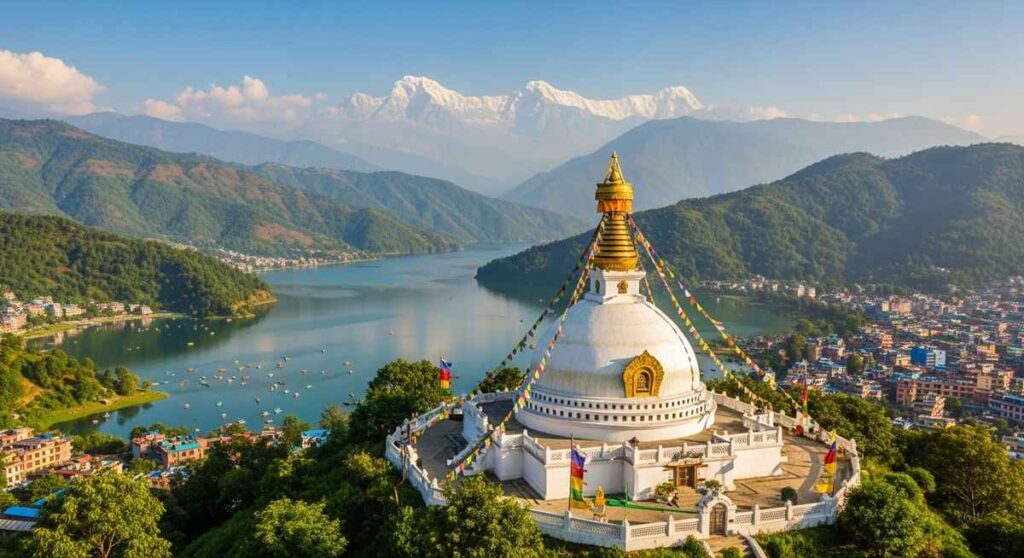
Some choose the walkway from Damside, while others drive to Chhorepatan and start the hike directly. Adventurers can even take a bike or motorbike along the rocky roads. No matter the route, the views are panoramic—from the Annapurna range to the Himalayan peaks, the valley, and Sarangkot Mountain. Early morning sunrise at about 1100 meters altitude is especially breathtaking.
The dome structure of the stupa, surrounded by golden Buddha statues, tells the story of peace. Built in 1973 by Japanese monks of the Nipponzan-Myohoji order, under Nichidatsu Fujii who was inspired by Mahatma Gandhi, it continues the tradition of shrines first begun in 1947. This gift to Nepal stands as a cultural site that brings tourists, Pilgrims, and travellers together in harmony and tranquility.
Around the town, small eateries offer great spots for lunch, and the German Bakery has become a famous landmark on the way. Both local and foreign visitors enjoy the peaceful surrounds. Entry is free, and the only cost is for the return trip across the lake, usually about NPR 810–1210.
4. Begnas Lake – A Quieter Alternative
Begnas Lake is a freshwater lake in the Pokhara Valley of Nepal, known for its scenic beauty, snow-capped mountain views, and peaceful surroundings. It is the third largest lake in Nepal and offers activities like boating, fishing, and hiking, making it a popular spot for tourists and locals alike.
The beauty of Begnas Lake lies in its freshwater, calm surface, and the way the snow-capped peaks like Annapurna, Manaslu, and Machhapuchare Himal reflect on the water. The lake sits in the Pokhara Metropolis of Kaski district, in the south-east of the Pokhara Valley.
It is the third largest lake in the country and the second after Phewa among the seven lakes in the valley. The water level fluctuates seasonally with rain and is carefully regulated by a dam constructed in 1988 on the western outlet stream Khudi Khola.
Around the area, there are resorts and peaceful spots that make it a popular destination for tourists visiting Pokhara. The water is also used in caged fisheries, while some swampy fields have been converted into paddy fields.
Visitors enjoy clear views of the Annapurna and Manaslu Range, along with the Fish-Tail peak. This picturesque scenery shows dramatic landscapes of green hills, farm villages, and terraces that surround the lake.
The distance from the main city is just 10 k.m. drive from Pokhara, and it is also easy to reach from Chitwan or Kathmandu. The road diverts from the highway to the north and soon arrives at the shore of this charming location.
The lake covers 3.28 square km at a height of 650 m / 2,144 ft, with a catchment area of 49 sq.kms and a depth of 6.6 m / 22 ft. Nearby lies Lake Rupa, separated by a ridge, where visitors can enjoy walking trails, boat rides, or fishing for silver carps, cat-fishes, feather-backs, eels, and other hill-stream fishes.
The tranquil location makes it perfect for relaxing mornings, with the reflection of the mountains shining on the calm water.
Around the lake, you’ll find international hotels, shops, and a small market, yet the local villages maintain their life and cultures, offering a touch of simplicity and happiness. Many people also come here for short hikes, gentle walking trails, and to enjoy boating or fresh fish lunches by the shore.
With its serene atmosphere, beautiful landscapes, and fun activities, Begnas Lake is a true hidden gem in the Pokhara Valley. It remains a peaceful hotspot for both tourists and locals, a place where famous pictures are often taken, showing the mountains reflected on the lake.
Waterfalls, Caves & Gorges
5. Devis (Davis) Falls
In the heart of Pokhara in Kaski District, Nepal, lies Devis (Davis) Falls, a breathtaking extraordinary waterfall. Locally called Patale Chango, Patale Chhango, पाताले छाँगो, or Paatal Ko Chango, the name means Underworld’s Waterfall or Fall of the Netherworld.
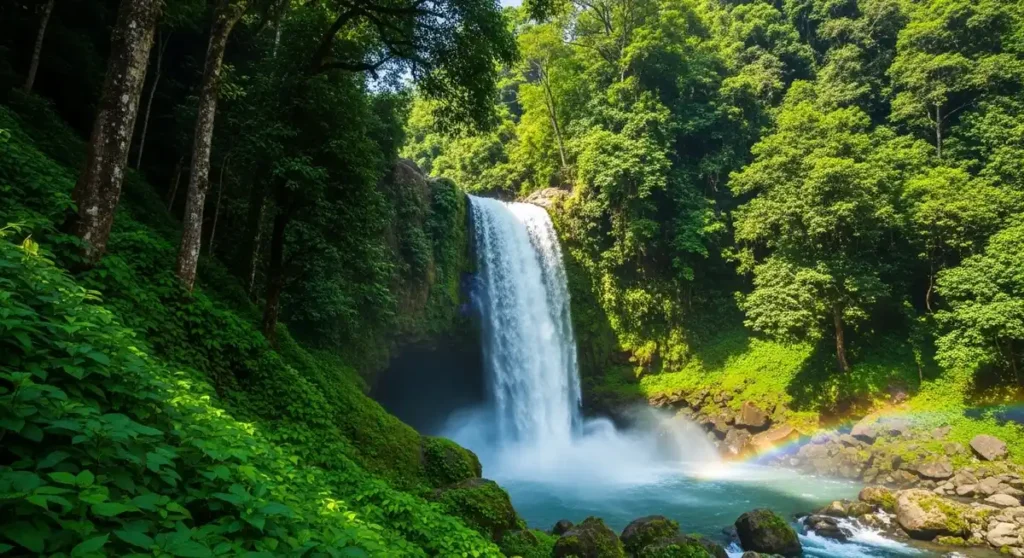
Many also know it as Davis Waterfall, Davi’s Fall, or even David’s Fall. The fall is unique because the water flows down with a mighty roar, creating a misty spectacle, then suddenly vanishes into a natural underground tunnel. This magical phenomenon is why it is also called The Disappearing Falls.
The underground tunnel, stretching 500 feet (150 m) and going 100 feet (30 m) deep, makes the fall different from others. Fed by the Phewa Lake water source and the Phewa Lake Dam, the water splashes powerfully on rocks, boulders, and the cliff, especially during the monsoons.
Visitors admire its beauty, the surrounding mountains, moving clouds, and the emerald green valleys. Bright flora and colourful flowers add to the charm, while some people give offerings and prayers to the goddess Devi, the local goddess, believed to watch over the place. The site reflects the grandeur of nature and sparks curiosity, imagination, and adventure.
6. Gupteshwor Mahadev Cave
Gupteshwor Mahadev Cave is a sacred cave in Pokhara, Nepal, near Davis Fall in Chhorepatan, Kaski district. Known as Bhalu Dulo in the Nepali tongue (गुप्तेश्वर महादेव गुफा), it is one of the most famous attractions, stretching hundreds of meters, with holy shrines of Shiva and a natural waterfall flowing through.
Visitors can see stalagmite Lingam, statues of Hindu deities, and enjoy the peaceful atmosphere inside. The entrance has a large brown arch, souvenir shops, and a ticket counter (entry Rs.50–Rs.100).
The cave is full of history as it was discovered in the 16th century, though the main entrance was only constructed in 1991. Inside, there are chambers, shrines, and a temple where a Shiva Linga is worshipped. A cow above the Linga makes the place even more sacred, and there is also a donation box for offerings.
Walking further, you pass a spiral staircase, balcony, and concrete steps, leading to the inner trail where the walls glow with colors and traditional artworks inspired by the Kathmandu valley paintings.
During the monsoon season, part of the cave is closed because of high-water levels, but most of the year, the underground path is open for travelers.
The highlight is the metal staircase leading to the waterfall inside, where the sound of rushing water fills the cave. Visitors often light an incense stick, admire the souvenir shops, and enjoy the mix of modern-day construction with natural beauty.
The peaceful atmosphere, far from the hustle and bustle of the city, makes this Location a must-see. From the World Peace Stupa above to Devi’s Fall upstream and the downstream cave, every part is truly worth a watch for both locals and foreigners.
7. Mahendra Cave
Mahendra Cave in Pokhara, Batulechaur, Kaski district is a beautiful limestone cave with stunning stalagmites, stalactites, and a statue of Hindu Shiva. It is a popular tourist attraction in Nepal, known for its natural patterns, shapes, and rich history. Visitors can explore with guides, use torches, and enjoy nearby spots like Davis Falls, Gupteshwor Mahadev, and Fewa Lake.
Inside the cave, I saw the magical stalagmites and stalactites shining on the ceilings and the earth below. The locals believe the unique patterns and shapes reflect different gods. A statue of Hindu Shiva stands inside, making it both a natural and spiritual wonder. The tourist community loves its allure and the peaceful valley setting.
The cave is named after King Mahendra Bir Bikram Shah Dev. Long ago, two shepherds discovered it, and now many tourists visit with the help of guides. There is lighting with bulbs, and visitors also bring torches or use emergency lights.
The exit is narrow, but safe with proper navigation. Near the foothill, the view is green and inviting, and close by are attractions like Devi’s Falls and a small temple.
A short walk leads to the Bat Cave, also called Chameri Gufa in Nepali. Here, the Bats rest on the wall and surface. The nearby Mahendra Gupha or House of winged residents is another highlight. From the north of Pokhara, it takes about a two-hour walk to reach.
Using a torch, I enjoyed watching the winged residents. On weekends, many visitors come, making the cave lively. The land, its formation, and its history make it one of the most unique places in Nepal.
8. Seti River Gorge
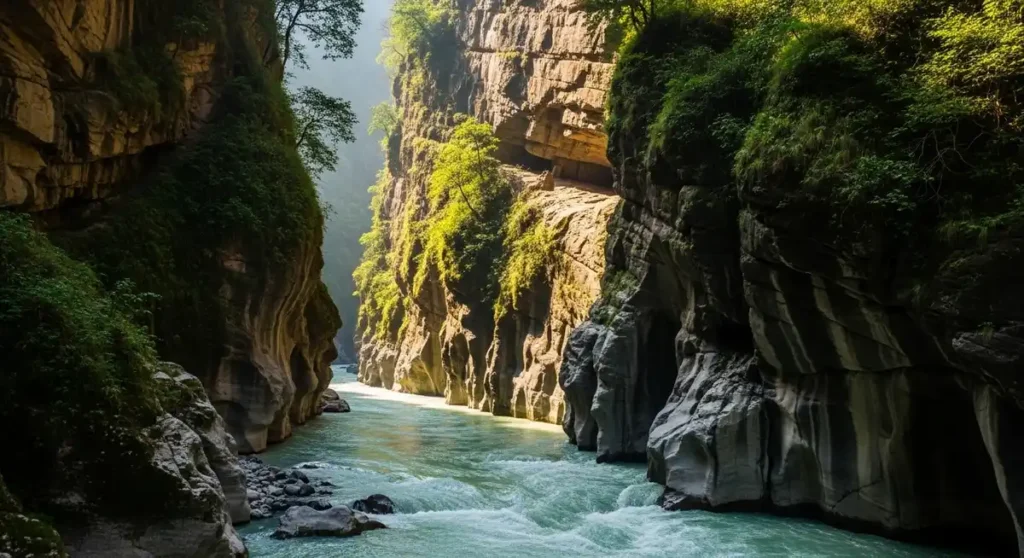
The Seti River Gorge is one of the most beautiful sights in Nepal. The Seti River, also called the White River, flows through the Mahabharat range and makes a deep gorge that looks magical. In the city of Pokhara, the river passes under caves and tunnels.
From Mahendra Pul, K.I. Singh Pul, or Prithvi Chowk Pul, you can see the roaring stream and its ferocity as it moves through the chasm. Over millennia, the Annapurna Massif waters shaped this land, creating views near Old Pokhara and the Gurkha Museum that are truly impressive.
Rafting here is full of adventure and excitement. The gushing rivers make a joyful string of waves, giving both thrill and fun. The water is known to be among the warmest, which makes the ride smoother.
Surrounded by a valley of scenic beauty, the journey fills visitors with awe. The bumpy ride can be marked as Easy to Moderate, with a Duration of about 90 Minutes and a Price starting from INR 3180.
In the monsoon season, the water levels rise, and from the bridge up high, the view becomes even more powerful. Many tourists enjoy this wonder, and spending extra time here is always rewarding.
Culture, Temples & Museums
9. Bindhyabasini Temple & Old Bazaar
Bindhyabasini Temple & Old Bazaar in Pokhara is a historic and cultural treasure. The temple, dedicated to goddess Bhagwati, sits on a hill with views of the Himalayan ranges, while the nearby Old Bazaar showcases Newar architecture, traditional shops, and a lively Nepalese atmosphere. It is a famous sightseeing attraction for both pilgrims and tourists.
The Old Bazaar in Pokhara, also called Purana Bazaar or Purano Pokhara, is full of charm. You can reach it by local bus and enjoy narrow streets lined with red brick houses built in Newar architecture.
The place reflects the old trading route once used by Newar traders coming from Tibet and the Kathmandu Valley. Walking here feels like stepping into history, with a strong Nepalese atmosphere surrounding the shops, restaurants, and homes.
The nearby Bindhyabasini Temple is the spiritual heart of this area. Located in Ward No. 2, Miruwa, the temple rests on a hill and is reached by stone staircases from the East, North, and South-East. It is dedicated to goddess Bhagwati, also known as Kali, a form of Shakti.
Inside, visitors also find shrines of Saraswati, Shiva, Hanuman, and Ganesha. The Statue of Lord Hanuman covered in Sindoor and the figure of Lord Ganesha greet devotees at the entrance.
As one of Nepal’s oldest temples, it is built in Pagoda Style and holds great religious significance. On Saturdays and Tuesdays, many worshippers, pilgrims, and tourists gather for sacrifices and ceremonies, giving the temple a festive flavor.
Standing atop a white dome and stone courtyard, the Bindhabasini Temple is not only a sacred shrine but also a serene place for cultural discovery.
From here, you can see the Himalayan ranges, the Pokhara valley, and even enjoy a peaceful boat ride on the nearby lake. The temple is known as one of the important Shaktipiths of western Nepal and is celebrated for its role in Hindu culture.
Many visitors also witness a traditional Nepalese wedding here. Located close to the Pokhara-Baglung Highway, it is a must-visit tourist destination in the city of lakes, especially in October when the weather is at its best.
10. Tibetan Monasteries & Refugee Camps
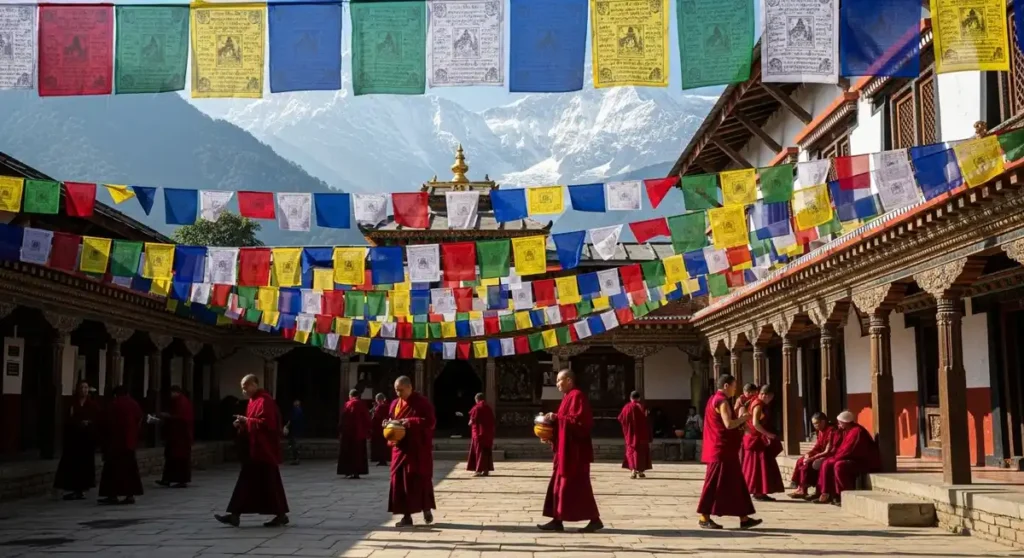
The Tibetan Monasteries & Refugee Camps were created after the China invasion of Tibet in 1959, giving Tibetans new settlements in India and Nepal. These communities became cultural and religious centers, keeping alive the arts, traditions, and heritage of Tibet.
The camps are peaceful with monks, prayer flags, and the gentle sound of chants. During festivals in December, January week, and the New Year February, visitors can enjoy masked dance performances and the joyful ambiance of celebration. The community also shares beautiful handicrafts, giving visitors opportunities to learn and take part in the true essence of Tibetan life.
11. International Mountain Museum
The International Mountain Museum (IMM) in Pokhara, Nepal is one of the most fascinating museums I have visited. It was inaugurated on 5 February 2004 and built by the Nepal Mountaineering Association (NMA), first established on 1 Nov 1973. The foundation stone was laid on 1 Dec 1995, and the soft opening took place on 29 May 2002 before its full opening.
Inside, there are exhibition halls like the Hall of Mountain People, showing customs, traditions, and the way of life; the Hall of World Mountains, with geological facts, origins, and details about peaks over 8000 meters; and the Mountain Activities Hall, which is dedicated to trekking, ascents, explorations, and the advancement of climbing gear and equipment.
I admired the displays about great figures such as Kumar Khadga Bikram Shah, the founder president of NMA; Dr Toni Hagen, a geologist who created the first pictorial Nepal; Reverend Ekai Kawaguchi, the first Japanese to visit in 1899; and Dr Harka Gurung, a scholar, geographer, development planner, and Tourism Minister.
The theme “Man, Mountain, and Mountain Activities Around the World” shapes the entire display area, which is beautifully divided into sections. Outside, visitors can even climb a 21m wall and a 9.5m model of Mt Manaslu. A taxi from Lakeside takes about Rs 800 return, making it easy to reach.
This Museum has welcomed over 2.1 million tourists by 2019 and continues to inspire mountaineers, climbers, and all who love the Himalaya. It is a place of success, heritage, and culture, just like the Tibetan Monasteries & Refugee Camps.
12. Gurkha Memorial Museum
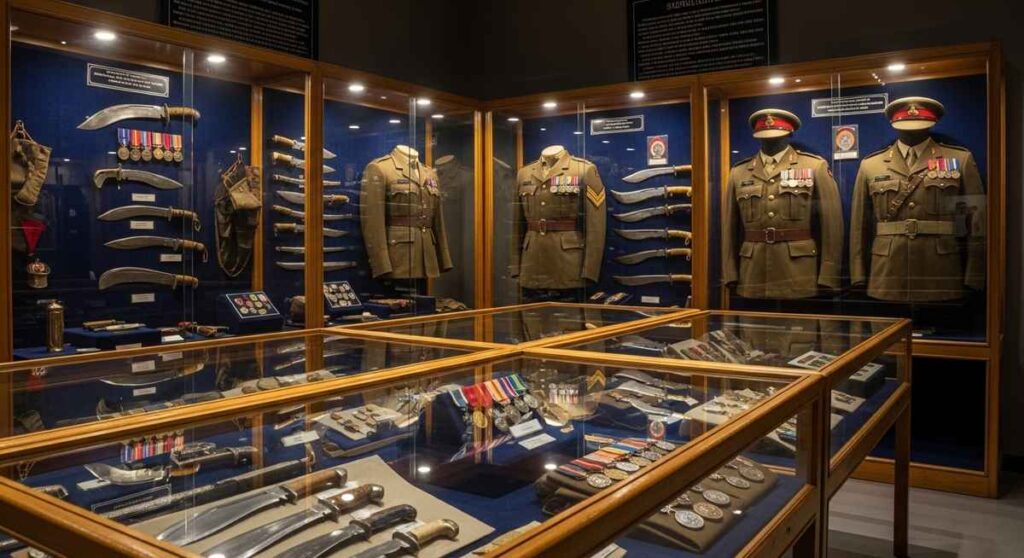
In the heart of Pokhara, the Gurkha Memorial Museum stands as an amazing and impressive place that celebrates the legacy of the Gurkhas.
It shares their story through photographs, sound, and video that bring alive their dedication, contribution, and unity. Walking through the halls, I saw the traditional Khukri knife, shining uniforms, and medals that left my jaw dropped with pride.
The story traces back to the Gorkha district, the birthplace of the word Gurkha. Here, Prithvi Narayan Shah began the unification of small states into a powerful nation. Over time, the British and Indian army welcomed these fierce soldiers into their forces. Their courage in World War 1 and 2 brought them worldwide respect, with each name engraved in history.
Visiting in October felt perfect, with the valley around adding beauty to the location. For Rs100 or Rs200, and an extra Rs20 for a camera, the experience was worth every moment. This renowned museum is a true representation of bravery, peace, and prosperity, making it one of the top highlights of Nepal’s history and culture.
Adventure Sports in Pokhara
13. Paragliding
Flying in the skies of Pokhara is a true adventure and one of the most loved sports in Nepal. Many join this thrilling activity at famous tandem flying spots. The stable thermals, smooth take-off, and gentle landing near the lake make it an ideal choice. The Himalayan views with a skilled pilot guiding the glider give a comfortable and safe flight every season.
At Sarangkot Hill, about 1600 meters high, the sky feels alive. The aerial experience of flying over the Fewa valley and the Himalayas is breathtaking. On clear days, the airspace fills with eagles, vultures, griffins, and kites.
Below, you can see villages, temples, monasteries, jungles, and the shimmering lakes. The snow-capped Mount Fishtail, Annapurna, and Dhaulagiri range make the scenery unforgettable.
The flights run through the year, with the best months being September, October, November, December, February, March, April, and May. The Pame landing site is well managed by experienced, licensed, and certified pilots, approved by the Civil Aviation Authority of Nepal Government.
The flights can be standard, lasting about 30 minutes, or a longer cross country journey. The ride begins with a short drive up to the launch point, and then comes the joy of floating over Phewa with picturesque views of the mountains in the distance.
Packages are affordable, with prices in INR, Rs, or USD, and even dropped further in 2024, making it budget-friendly for customers.
Many companies, agencies, and operators also offer extra services like GoPro footage, insurance, transfer from your hotel, and guidance from a professional instructor. Every session is truly exciting and full of thrill, leaving travelers with an unforgettable experience.
14. Ultralight Flights
Ultralight flights in Pokhara give you a chance to see the Himalayas, the Pokhara valley, and scenic lakes from the sky. These small aircraft are built with light frames and seating for only a pilot and a passenger, so the views feel open and free.
You can soar above the mountain peaks of Annapurna, Machhapuchchhre, Manaslu, and Dhaulagiri, enjoying aerial sightseeing with a truly majestic backdrop.
The flights are offered in different packages with flexible duration, from 15 to 90 minutes, so you can choose the best option for your time and budget. Flying here feels like being a bird in the sky, with a floating feeling as the plane glides through the clouds. Many travelers love to take photos of the panoramic landscapes, forests, lakes, and villages below.
This unique experience is safe, easy, and designed for people from all over the world. Whether it’s your first time or you’ve flown before, the views of snow-clad mountains and lush valleys will be worth it. It’s one of the most thrilling activities in Nepal, giving you memories to cherish for a lifetime.
15. Zipline & Bungee Jumping
For more adventure, Pokhara also offers bungee jumping and the world-famous Zipflyer. The bungee site features Nepal’s only tower jump, with a drop of over 100 meters that delivers an exciting free fall and a burst of adrenaline. The jump is surrounded by mountains, hills, and a flowing river, making it a breathtaking spot.
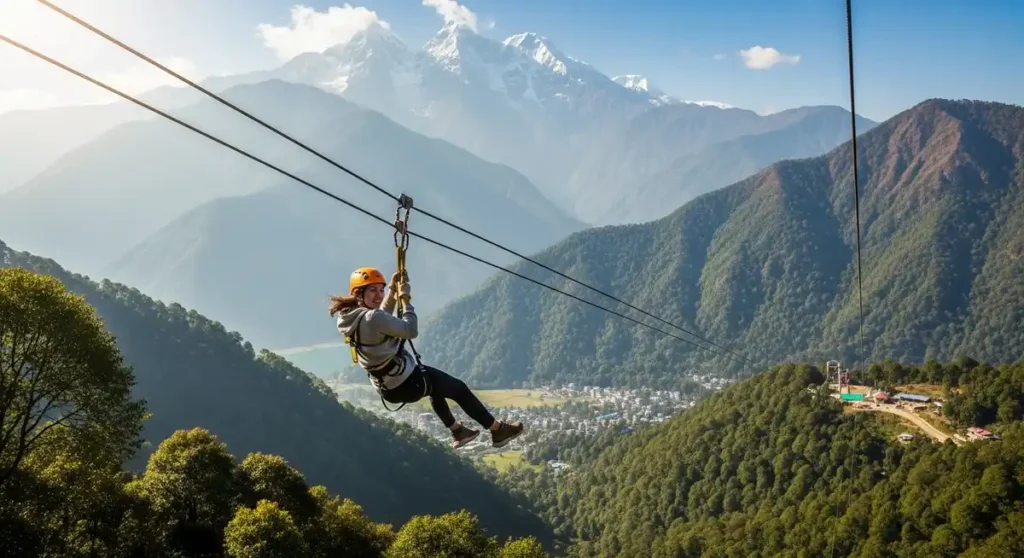
The Zipflyer by HighGround Adventures is known as one of the tallest, longest, and steepest ziplines in the world. With a 56-degree incline, a 1.8 km length, and speeds up to 120 km/h, it gives an unmatched rush as you glide above the rolling green hills with views of Mt. Machhapuchchhre. Couples and friends can even ride side by side on the two lanes, adding more fun to the experience.
Both activities can be booked as a combo package for a full day of excitement. Along with the thrill, visitors enjoy the landscapes, breathtaking views, and even a nearby restaurant at the end of the ride. The mix of weightlessness, speed, and natural beauty makes it a must-try for any adventure enthusiast.
16. White-Water Rafting & Kayaking
Pokhara is one of the best places in Nepal for rafting and kayaking. With rivers like the Seti river and the Narayani river, every experience is full of fun and adventure. Many operators and travel agents help with booking, packages, and even Kayak clinics at learning centers for both a beginner or someone joining a four-day Kayaking expedition.
The Upper Seti river is a favorite for whitewater rafting. With class III+IV rapids, it gives the thrill of ferocious rapids, paddle calls from the guide Nim, and the cool splash of glacial waters. The short half-day trip is action packed, and a great adrenaline fix. Many people enjoy a cliff jump, or relax at the end with a quick lunch and even a Coke before the drive back to Pokhara.
Paddle Nepal is a trusted company with world-class rafting experience. They have guided expeditions, multi-day options, and even a Kayak clinic with meals, accommodation, and equipment like helmet and life jacket. October and November are the best time to visit when the rivers run clear blue. From tourist information centres, you can find details about pricing, costs, and what’s included in each trip.
From paragliding near Lakeside to rafting companies offering great adventure, Pokhara has become the heart of Nepal’s rafting scene. The Annapurna mountain range and prayer flags on the suspension bridge make it a beautiful setting for adventure seekers.
17. Mountain Biking
The countryside around Pokhara is perfect for Mountain bikes and bike tours. Riders go through fields, hamlets, over suspension bridges, along river banks, and up hills near temples and the highway. There are many exciting routes such as Phewa Lake, Pokhara-Sikles, International Mountain Museum-Kotre, Pokhara-Sarangkot-Naundanda, and Pokhara-Sundari Danda-Begnas Lake.
Bicycle rental shops across the city offer well-maintained bikes. On the main street near KFC, you can find bike rental and hill tours to places like the World Peace Pagoda. With prices starting from $70, you can enjoy half day mountain biking trips, or longer ones for more activities.
Planning and budgeting early helps. It is easy to find a legit provider or vendor that gives you great options. Whether you like a relaxing ride at Begnas Lake, a full-day biking tour, or the ridges of Sarangkot Hill, Pokhara has it all.
Some adventurers choose Active Mountain Biking, while others go on motorbiking tours. With a motorbike, you can ride out to Jomsom, Tilichio Lake, Manang, or Mustang, passing jungles and barren lands. The apple gardens along the way make it even more enjoyable.
Every year, bikers from around the world come to Pokhara. Riding through the Annapurna Himalayas, whether on motorbikes or mountain biking tours, is one of the best things to do in Nepal for nature and adventure lovers.
18. Hot Air Balloon Ride
Taking a Hot Air Balloon in Pokhara feels like flying like a bird. From the basket, travelers enjoy the panoramic views of mountains, rivers, villages, and the green landscape. On clear days, the wind carries the balloon smoothly, offering sights of Mount Dhaulagiri, Mount Hiunchuli, Lamjung Himal, Manaslu, and the peaceful valley below.
The first flights in Nepal began in November 2018, and today the rides are one of the most loved adventure sports for tourists. The experience lasts around 30 to 40 minutes, with the popular Eagle Eye flight taking off from Dhampus or Laurukh. Watching the sunrise or sunset from the blue sky gives travelers a true lifetime memory.
Packages are available at a fair cost for foreigners, Indian, SAARC, and local citizens. Prices are often lower than in other countries. The best months are September to May, when the weather is clear and stable. The operator suggests wearing warm layers and good shoes for comfort.
A flight over Phewa Lake, the ranges, and the shining city of Pokhara is more than travel—it is an unforgettable journey into the heart of Nepal’s natural beauty.
Treks & Hikes Around Pokhara
19. Annapurna Base Camp (ABC) Trek
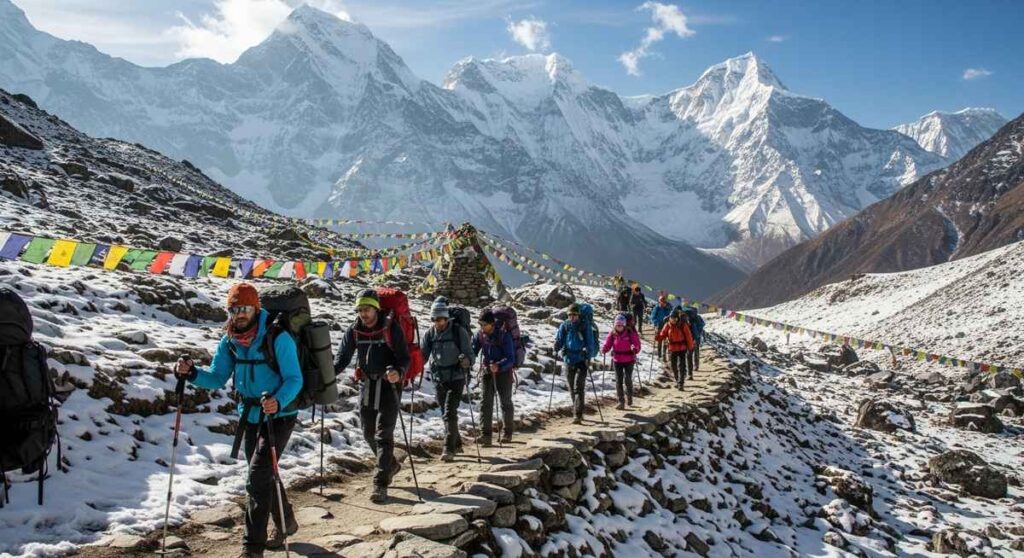
The Annapurna Base Camp Trek is a true Himalayan adventure in Nepal. The trail passes through forests, rice terraces, and villages, leading to the Base Camp at 4,130 meters.
Along the way, trekkers enjoy picturesque landscapes and mesmerizing panoramic views of the Annapurna Massif, Machhapuchhare (Fishtail Peak), Hiunchuli, and more. At sunrise and sunsets, the mountains glow with alpenglow, creating unforgettable moments.
This trek offers a mix of cultural heritage and natural beauty. The Gurung, Magar, Thakali, and Loba communities share their warm hospitality, traditions, and vibrant customs.
Trekkers also experience the healing geothermal waters of the Jhinu Danda hot springs, adding a refreshing pause to the journey.
From Pokhara, there are multiple routes designed by different tour operators, often including Ghorepani Poon Hill for its iconic sunrise views.
The suspension bridges, waterfalls, and terraced farmlands along the way add to the trek’s charm. Whether traveling solo or with a group, it is one of Nepal’s most popular treks and a true once-in-a-lifetime experience.
20. Mardi Himal Trek
The Mardi Himal Trek is a shorter and moderately challenging trek in the Annapurna region. Starting from Pokhara, the trail moves through rhododendron forests, peaceful meadows, and high ridges leading to Mardi Himal Base Camp at 4,500 meters.
The trek is known for its stunning views of Machhapuchhre, Annapurna, and other Himalayan peaks.
It is perfect for beginners, families, and experienced trekkers alike. The well-maintained trails with gradual ascents make it accessible, while the pristine landscapes and breathtaking splendor at the View Point and High Camp offer incredible rewards.
Many itineraries allow the trek to be completed in 3–5 days, and it can also be combined with Poon Hill, Khopra Ridge, or the Annapurna Base Camp Trek for longer adventures.
With strong support from local guides and fellow trekkers, the Mardi Himal Trek is a true bucket list adventure in the Himalayas, offering unique memories and enriching experiences.
21. Ghorepani–Poon Hill Trek
The Ghorepani–Poon Hill Trek is one of the most loved short treks in Nepal. It passes through green forests, stone-paved trails, and lively villages before reaching Poon Hill at 3,200m.
Here, the glowing sunrise over Dhaulagiri, Nilgiri, Annapurna I, and Annapurna South feels magical. This trek is easy for beginners and gives a taste of a full mountain trek with teahouses, friendly locals, and wide panoramic views.
Families and children enjoy it because the foothills do not bring risks like altitude sickness but still give breathtaking mountain peaks and valleys.
The trail continues through rural villages, terraced slopes, rice paddies, and maize fields. Trekkers meet Magar and Gurung people, known for their warm hospitality, languages, and cultural traditions.
With flexible itineraries, many combine the trek with the Annapurna Circuit or Annapurna Base Camp, using it as an acclimatization trek. This route is part of classic short treks in the Himalayas, loved for its views, culture, and rich adventure.
22. Dhampus–Australian Camp (Short Trek)
The Dhampus–Australian Camp Trek is another wonderful short hiking experience. Starting from Pokhara, a quick drive to Phedi begins the walk.
The first stop is Dhampus, a village of the Gurung people with traditional houses, green hills, and kind locals.
Walking further brings travelers to Australian Camp, where the views of the Annapurna massif, Machhapuchhre Himal, Hiunchuli, Annapurna South, and the wide Annapurna ranges open up. The glowing sunrise and calm sunset here create lasting memories.
The path is easy and well-paved with flag-stones, winding through rhododendron and oak forests, past terraced fields and small communities like Naudanda.
Travelers may hear local stories, visit a Buddhist monastery, and enjoy the peaceful Sanctuary. This trek is ideal for families and those with little time who want both nature and culture.
Guided by companies like Swiss Family Treks and Expedition, the journey feels safe, friendly, and rewarding. With a short itinerary, this trek shows the true heart of the Himalayas, from the charm of towns to the beauty of snowy peaks.
Conclusion
Pokhara is more than a stop on the map—it’s where nature, culture, and adventure blend into timeless memories. Whether you crave thrill, peace, or heritage, this Himalayan city welcomes you with open arms and endless wonder.
FAQs: Things to Do in Pokhara
What is the famous thing of Pokhara?
Pokhara is famous for its beautiful lakes, stunning Himalayan views, and peaceful vibe. Phewa Lake, Sarangkot sunrise, and the World Peace Pagoda are top highlights. It is also the gateway to the Annapurna treks and offers fun activities like paragliding, boating, and hiking.
How many Muslims are in Pokhara?
Pokhara is home to a diverse community with Hindus, Buddhists, and Muslims living together. The Muslim population is a small part of the city but plays an important role in the cultural mix. You can find mosques and local Muslim neighborhoods where traditions are kept alive.
How many days are sufficient for Pokhara?
Two to three days are enough to enjoy the main sights like Phewa Lake, Sarangkot, and caves. If you love trekking or adventure, you can spend a week or more. Many travelers choose 4–5 days for a good balance of rest and activities.
How to dress in Pokhara?
Dress comfortably with light clothes in warm months and layers in cooler months. Casual wear works well, and modest clothing is best for visiting temples or monasteries. Good walking shoes are useful for hikes and lakeside strolls.
Is Pokhara worth visiting compared to Kathmandu?
Yes, Pokhara is worth visiting because it feels calm and close to nature. Kathmandu is lively with history, while Pokhara gives mountain views, lakes, and adventure. Many travelers enjoy both cities for their different charms.
Can you see Everest from Pokhara?
Everest is too far to see from Pokhara. But you can see amazing peaks like Annapurna, Dhaulagiri, and Machhapuchhre. For Everest views, a flight from Pokhara or Kathmandu is a good choice.
What are the best things to do at night in Pokhara?
At night, you can enjoy lakeside cafes, live music, and local restaurants. Walking by Phewa Lake under soft lights feels relaxing. Some visitors join cultural shows or sit in cozy bars with mountain views.
Which is better: Begnas or Phewa Lake?
Phewa Lake is lively with boating, markets, and the Tal Barahi Temple. Begnas Lake is quieter, perfect for peace and mountain reflections. Both are beautiful, and your choice depends on whether you like calm or a more social vibe.
Do I need permits for hikes near Pokhara?
Yes, you need permits for most treks near Pokhara. The Annapurna Conservation Area Permit (ACAP) and TIMS card are common. You can get them in Pokhara before starting your hike.
What to do in Pokhara when it rains?
On rainy days, you can visit caves like Gupteshwor or Mahendra, or explore museums. Enjoy coffee in lakeside cafes while watching the rain. Spa, yoga, and shopping in local markets are also fun options.
Is 2 days enough for Pokhara?
Yes, 2 days is enough to see main attractions like Phewa Lake, Sarangkot sunrise, and Davis Falls. You can also enjoy a short hike or boat ride. If you want trekking or more adventure, plan extra days.
What are the best souvenirs to buy in Pokhara?
Popular souvenirs include handmade crafts, singing bowls, pashmina shawls, and Tibetan jewelry. You can also find local paintings, wooden carvings, and colorful prayer flags. Lakeside markets and bazaars are the best places to shop.
Disclaimer
This travel guide is for informational purposes only. Experiences, prices, and timings may change. Always check local updates before your trip. Content by TravelDrizzle.com.
